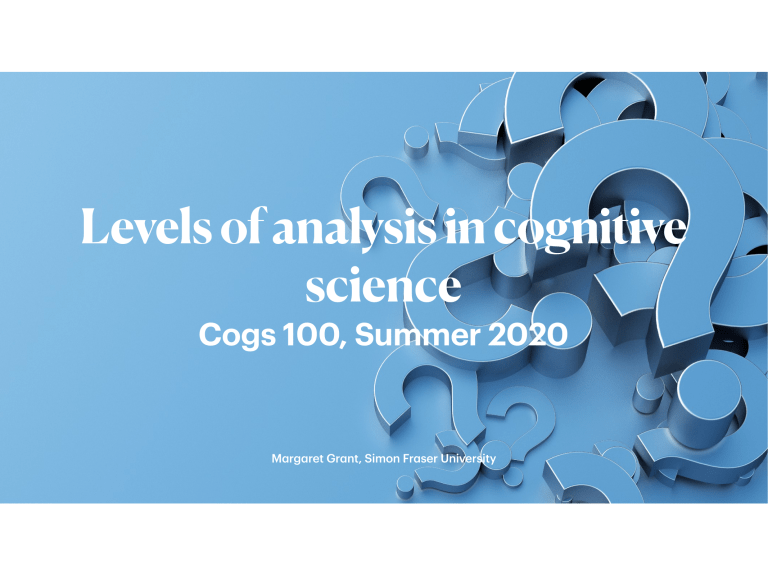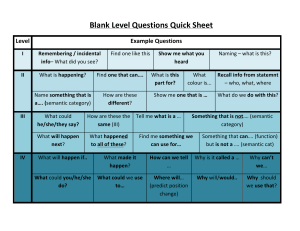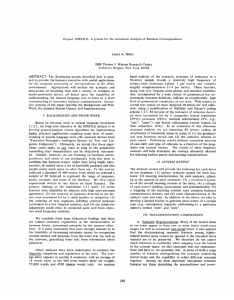
Levels of analysis in cognitive science Cogs 100, Summer 2020 Margaret Grant, Simon Fraser University How can we describe a mental machine? • • So far, we have introduced the idea that our minds might work like a computer. • • The mind as an information processing device. Computations that are performed on symbolic representations. Normally we study a sub-program of the mind - e.g., memory, attention, language etc. Let’s call these mental machines for now. • What questions would we want to know about such a mental machine? • • What does it do? How does it do it? How can we describe a mental machine? • • So far, we have introduced the idea that our minds might work like a computer. • • The mind as an information processing device. Computations that are performed on symbolic representations. Normally we study a sub-program of the mind - e.g., memory, attention, language etc. Let’s call these mental machines for now. • What questions would we want to know about such a mental machine? • • What does it do? How does it do it? ← This one we will split into two. The tri-level hypothesis (Marr, 1982: Vision) The tri-level hypothesis • Any information processing task (call it a ‘machine’) needs three levels of explanation: • • • The computational level The algorithmic level The implementational level The tri-level hypothesis • Any information processing task (call it a ‘machine’) needs three levels of explanation: • • • The computational level The algorithmic level The implementational level The computational level • • What information-processing problem is this machine trying to solve? What are the inputs and outputs of this machine? Example: Vision • • • Marr: The pattern of light hitting the retina cannot uniquely determine the arrangement of objects (underdetermination). The visual processing ‘machine’ (our visual system) must constrain the space of possibilities. Information we know about the world is applied in interpreting information from the eye. ‘The dress’ Limitations of the computational level Weak equivalence • • Two machines can have the same inputs and outputs but accomplish this by very different means. When two machines have the same inputs and outputs we call them weakly equivalent. • vs. strongly equivalent - when the same procedures are involved. Example: Chess-playing • • • Say a parent teaches a child to play chess. The child learns the legal moves for each piece, but no overall strategy. The parent and child both ‘play chess’, but are they doing the same thing at the computational level? Dawson, 1999 Weak equivalence and the Turing test • Turing (1950) on the question of whether machines can think. ? Try it for yourself: https://www.masswerk.at/elizabot/eliza.html CAPTCHA Completely Automated Public Turing test to tell Computers and Humans Apart The tri-level hypothesis • Any information processing task (call it a ‘machine’) needs three levels of explanation: • • • The computational level The algorithmic level The implementational level The algorithmic level • • How do we get from input to output? Functional decomposition apart from any physical infrastructure. • What to the parts of machine do rather than what they are made of. Example: Memory • • Question: Is memory a unitary storage locker? Peterson & Peterson (1959): There is a short-term store of memory and a long-term store. • • In the short-term store, information decays very quickly. Information must be processed further (rehearsed) in order not to be lost. See Dawson (1999) for further description Let’s try it out Memorize these words frogs transport nation load clean macho disaster carpenter railway position Write down the list of words Serial position effects Recall task delay Recency effect Proportion recalled 100 75 Recall task delayed: Recency effect attenuated Primacy effect 50 25 0 0 3 6 Presentation rate increased/low frequency words used: Primacy effect attenuated 9 12 15 18 21 24 27 30 Position of item in list Conclusion: These two effects are subserved by different parts of the human memory system. Serial position effects • • • • The influence of different independent variables on primacy vs. recency effects in memory led researchers to conclusions about the human memory system. First items are rehearsed and pass from a short-term to a long-term memory store. Last items have not yet decayed from short-term memory. These hypotheses are at the algorithmic level (no necessary hypothesis about how these are implemented in the brain). The tri-level hypothesis • Any information processing task (call it a ‘machine’) needs three levels of explanation: • • • The computational level The algorithmic level The implementational level The implementational level REVIEWS • inputs from multiple semantic regions over its duration of several hundred milliseconds, some or all of which may contribute to the effect in a particular paradigm134,147,159. In addition to the posterior middle temporal effects, a subset of studies also show effects in inferior frontal regions, probably reflecting differences in ease of selection or retrieval or — in some models — integration with world knowledge. These effects may be reflected in a subsequent late positivity, but they may also contribute to the N400 effect. The anterior temporal cortex may also contribute to the scalp-recorded N400 but fail to be represented in fMRI data for method-specific reasons. Although we cannot discriminate between these possibilities yet, the framework described here generates specific anatomical predictions that can be tested more systematically, with a focus on examining the convergence and divergence of particular aspects of the signal in different methodologies across psycholinguistic manipulations. The data reviewed here support the framework for semantic processing that is presented in FIG. 5. Amodal lexical representations, linked to distributed semantic representations throughout the cortex, are stored and activated in the posterior middle temporal cortex and in parts of the neighbouring STS and IT. These representations are more easily accessed in predictive or priming contexts, leading to a reduction of activation that is reflected in the N400 effect and in corresponding BOLD signal reductions. During sentence processing, these lexical representations are accessed by the anterior temporal cortex and angular gyrus, which integrate the current input into the semantic and syntactic context that is under construction. The anterior inferior frontal cortex mediates top-down controlled semantic retrieval of lexical representations, which is partially based on the updated representation of the global semantic structure that is provided by integration areas. This top-down retrieval facilitates lexical access, indirectly contributing to a reduction in MTG activity. The posterior inferior frontal cortex mediates selection among highly activated lexical representations, partially based on the current global semantic representation. Most of the contextual manipulations focused on in the second part of this Review allowed pre-activation of lexical information, and thus highlighted the role of the posterior middle temporal cortex in the processing of words in context. Paradigms that selectively manipulate integrative processes at different levels of representation (that is, syntactic, semantic and discourse levels) will be needed to provide more evidence for the contributions of the combinatorial and control regions proposed by the model, which are less well established. The physical architecture of the machine. • • Neuronal structure in the brain (neurons, synapses). Parts of a computer connected together (transistors, wires etc). pIFG AG aIFG ATC MTG Figure 5 | A functional neuroanatomic model for semantic processing of words in context. Lexical Nature Reviews | Neuroscience representations are stored and activated in the middle temporal gyrus (MTG) and in the nearby superior temporal sulcus and inferior temporal cortex, and are accessed by other parts of the semantic network. The anterior temporal cortex (ATC) and angular gyrus (AG) are involved in integrating incoming information into current contextual and syntactic representations. The anterior inferior frontal gyrus (aIFG) mediates controlled retrieval of lexical representations based on top-down information, and the posterior IFG (pIFG) mediates selection between highly activated candidate representations. conceptual features). In support of this possibility, several ERP studies show a contextual priming effect similar to the N400 effect for pictures15–17,160, videos161,162 and environmental sounds112,163,164, although the scalp distribution of these effects is slightly different from the standard N400 effect for words. A focused programme of research investigating the response properties of MTG neurons and/or ensembles will be required to elucidate the MTG’s contribution to lexical representation and processing. Second, although our model proposes that several regions are likely to be involved in semantic integration, the notion of integration requires specification both at the level of cognitive models and at the level of neuronal mechanisms. For example, psycholinguistic models of the integration of words into larger units, such as sentential and discourse representations165–167, have rarely been linked to neurophysiological findings109. We have suggested here that integration covers multiple sub-mechanisms: encoding compositional structure, generating expectations, linking input with world knowledge, and controlling communication between different information sources. However, we leave open the specific technical implementation of these mechanisms; it seems plausible that integration at different representational levels will be associated with Section summary • Marr proposed three levels of analysis that are important for understanding any (mental) ‘machine’. • • • The computational level - what? The algorithmic level - how - functional description. The implementation level - how - physical implementation





